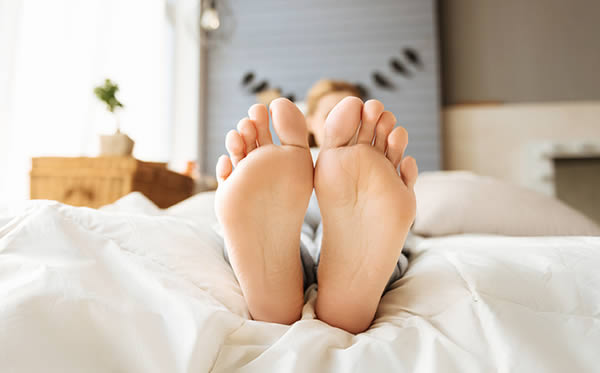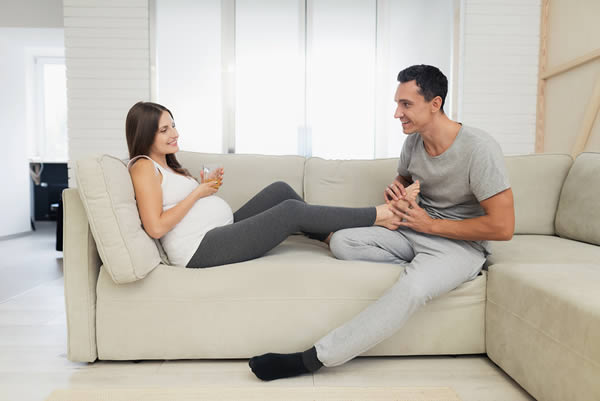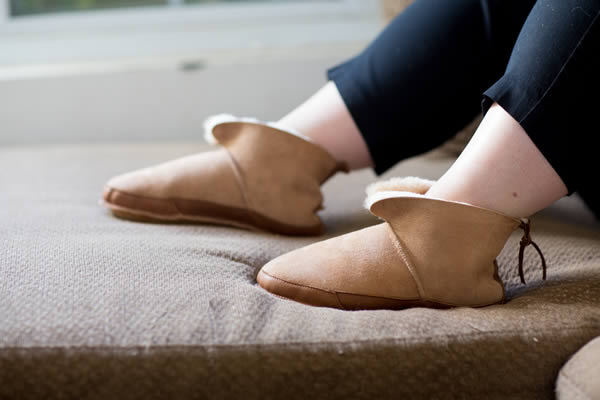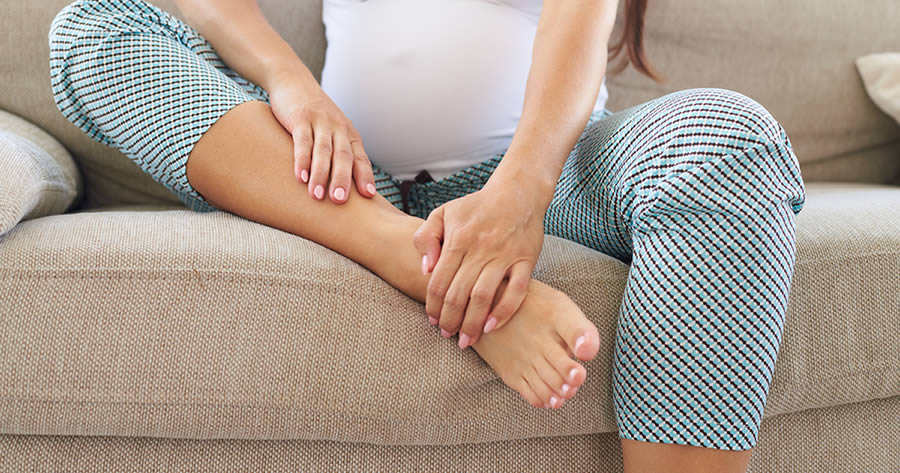Pregnancy and Your Feet: Swelling, Growth, and Foot Care Tips
Your body undergoes many transformations during pregnancy, and changes to your feet may not be at the top of your research list when you find out you’re expecting. Yet, issues with your feet will pop up during your nine-month journey and it’s helpful to know in advance what you can expect and how best to take care of them. We give you tips on how to care for and deal with foot growth and swelling during pregnancy.
Edema: Foot Swelling During Pregnancy
Swelling because of excess fluids—known as edema—is especially common for feet and ankles during pregnancy. Around three-quarters of pregnant women experience this symptom. The swelling often shows up between weeks 22 and 27, and come and go until you give birth.
Why does this occur? When you’re pregnant, the fluid levels and blood flow in your body increase to accommodate you and your growing baby. Sometimes these extra fluids accumulate in your tissues and lead to swelling. Because your feet and ankles are usually your body parts closest to the ground, the simple force of gravity means these body parts often experience the brunt of the swelling.
You may notice that foot and ankle edema varies throughout the day. Sometimes it’ll increase in the evening, for example, or it may even increase as a result of the weather (warmer temps can spell more swelling). The swelling usually goes down overnight.
There are several simple steps you can take to keep swelling under control:
- Avoid long periods of sitting or standing. Break up these stints with a short walk, stretching, or, if you’re able, lie down and elevate your feet for a bit (more on foot elevation later in this post).
- Get plenty of exercise. This helps keeps your blood flowing throughout your body. Walking and swimming are great pregnancy-friendly exercises.
- Stay hydrated. More fluids to combat fluids? Actually, yes! Dehydration leads your body to retain more fluids. Plus, drinking enough water throughout the day will help flush out excess sodium and waste products, which minimizes swelling.
- Avoid tight socks and footwear. You don’t want extra pressure on your feet and ankles, so don’t sport any tight-fitting socks, tights, shoes or stockings. Keep things loose. Softstar shoes, with their soft, flexible materials, are a great choice for avoiding extra pressure on your feet.
- Stay cool. Find ways to cool off if the weather is hot or humid.
Generally, swelling is a normal symptom in the second half of your pregnancy and isn’t anything to be concerned about. It can, however, be a sign of preeclampsia, especially if it’s excessive and is paired with elevated blood pressure, rapid weight gain, and protein in the urine. Always talk with your health care provider about your pregnancy symptoms to rule out any serious conditions.
Does Pregnancy Cause Foot Growth?

This is one of those surprising symptoms of pregnancy no one may have told you about. Yes, your feet can actually grow up to a full shoe size by the time you give birth! And, yes, the change is permanent—so depending on how much your feet grow and the types of shoes you typically wear, a shoe shopping spree may be on the horizon.
The reason many pregnant women experience foot growth has to do with a hormone called relaxin that’s circulating throughout your body. Your ovaries produce relaxin, which (as the name suggests) relaxes the ligaments in your pelvis and softens and widens the cervix in preparation for labor. Your feet, which are made up of dozens of bones and joints connected by a network of ligaments, can undergo changes as a side-effect of this hormone. All those foot joints and ligaments relax right at the same time as you’re steadily gaining weight, and as a result your feet may grow longer, possibly become wider, and your arch height may decrease. A study of pregnant women’s feet conducted at the University of Iowa found that 60 to 70 percent of women had larger feet five months post-delivery than they had during their first trimester.
You may be able to take some steps to limit the amount of foot growth you undergo during pregnancy:
- Avoid excessive weight gain. For optimal health for you and your baby, you want your pregnancy weight gain to be slow, steady, and within the recommended amount based on your BMI. Following these guidelines will also keep excess weight from putting extra pressure on the ligaments in your feet, perhaps limiting foot growth.
- Keep your foot muscles strong. Strong foot muscles help support your feet and arches. As we’ve shared over the years, one the absolute best ways to naturally cultivate long-term foot strength is by wearing minimal shoes such as Softstars. You can also try foot-muscle exercises before and during your pregnancy. For instance, try picking up and moving marbles with your toes. Also, stand up on your tiptoes and then come down and shift your weight back on your heels in a repetitive motion (toes, heels, toes, heels, etc.).
If you already wear Softstars and your feet grow slightly during pregnancy, there’s a chance you won’t have to replace as many of your shoes. Because the natural leather of Softstars stretches and forms to your feet so well, the extra give and stretch may accommodate slight foot growth.
How and Why to Elevate Your Feet

Mamas-to-be should keep one mantra in mind when it comes to their feet: Put ’em up! Elevating your feet brings a range of benefits, from helping to eliminate pressure on your legs and feet to decreased pain and swelling.
The most important benefit is boosted circulation. Your circulation suffers during pregnancy, and elevating your legs and feet leads to increase venous blood flow, meaning your heart is able to better deliver oxygen to the rest of your body.
Even if you’re not feeling particularly achy or swollen, putting your feet up still improves blood flow, which, if done regularly, could even help stave off varicose veins and deep vein thrombosis.
To elevate your legs, ideally you want to lie down and prop your legs and feet up in a comfortable position (such as on a big pillow) such that they’re slightly above heart-level. Try doing this for 15 to 20 minutes at a time, three to four times a day.
Comfy Pregnancy Footwear

Having some comfy indoor moccasins or slippers will feel like a godsend during your pregnancy. You want an option that’s soft, flexible (non-rigid) and temperature-controlling to best pamper your feet during those exciting final months before your little one arrives.
My favorite options are Roo elk leather moccasins and Fireside slippers. Both are incredibly soft and flexible, mold to your feet, and are the perfect house shoes to wear when you’re bustling from room to room, nesting and preparing for your baby’s arrival. Both styles are also lined with high-quality sheepskin fleece, which naturally controls temperature and keeps your feet from getting too hot or cold.
Looking for more ways to treat your feet? Try getting a massage or make yourself a relaxing foot soak. To make a soak, add a half-cup Epsom salts and a few drops of lavender essential oil to a shallow basin of warm water.
Please note: While we’re shoemakers who are passionate about foot health, we’re not doctors. Consult your health care practitioner about any foot conditions and pregnancy symptoms.

Shelley Stonebrook is a writer and editor who is passionate about the outdoors and environmental advocacy. She lives and gardens with her husband and daughter in Corvallis, Oregon.


